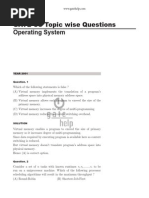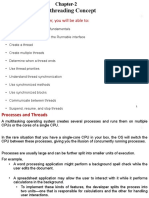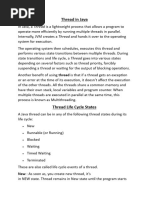Java Threading - The Executor Framework: Defining Threads in Java
Uploaded by
MaheshJava Threading - The Executor Framework: Defining Threads in Java
Uploaded by
MaheshJava threading – The Executor framework
June 4, 2009 | by Rafał Borowiec
The main goal of this article is to present the better mechanism of executing threads in
Java and to show that working directly with threads is no longer necessary. Thanks to
the Executor framework, working with threads in Java is easier. And there are people
who claim that working with threads in Java is easier than in most other languages.
Defining threads in Java
Multithreading is increasingly becoming the part of every modern application these
days. The program is multithreaded if it is able to run more than one thread at the same
time.
In Java, defining threads is straightforward and it is done either by extending the
java.lang.Thread class and overriding its run() method or, more common, by
implementing the java.lang.Runnable interface.
Let’s look at the example of defining a thread by implementing the Runnable interface:
1. class SomeRunnable implements Runnable {
2. @Override
3. public void run() {
4. for (int i = 0; i < 3; i++) {
5. System.out.println(Thread.currentThread().getName() + " counter="
6. + i);
7. }
8. }
9. }
To have the above code run by a separate thread the new java.lang.Thread object must
be instantiated and started as it is shown below:
1. public class Runner {
2. public static void main(String[] args) {
3. // instantiate a runnable object
4. Runnable runnable = new SomeRunnable();
5. // instantiate 2 threads and pass the runnable object
6. Thread thread_0 = new Thread(runnable);
7. Thread thread_1 = new Thread(runnable);
8. // start the threads
9. thread_0.start();
10. thread_1.start();
11. }
12. }
Using the Runnable interface is better than extending the Thread class. One of the
main advantages of doing that is the ability of using an Executor framework instead of
directly using the Thread class to create and execute new threads: constructing new
threads is relatively expensive because it involves interaction with the operating system.
The Executor framework
The Executor framework is a framework for standardizing invocation, scheduling,
execution, and control of asynchronous tasks according to a set of execution policies.
The Executor Framework was introduced in Java 1.5 and it is a part of
java.util.concurrent package. The main interface for the framework is Executor interface
and its subinterfaces: ExecutorService and ScheduledExecutorService. Please refer to
Executor API [ExecutorAPI] to see the detailed description of the interfaces.
Let’s take a look at the simple example of using the Executor framework to run
previously created task using fixed thread pool:
1. public class Runner {
2. public static void main(String[] args) {
3. Runnable runnable = new SomeRunnable();
4. // create a fixed thread pool
5. ExecutorService pool = Executors.newFixedThreadPool(3);
6. // run the task 5 times using the pool
7. for (int i = 0; i < 5; i++) {
8. pool.execute(runnable);
9. }
10. pool.shutdown();
11. }
12. }
In the above example I used the ExecutorService interface which is an Executor that
provides a number of useful methods to control the task execution. For creation of the
concrete ExecutorService I used the Executors class and one of its static factory
methods: newFixedThreadPool(). Please refer to Executor API [ExecutorAPI].
Task scheduling
The ScheduledExecutorService is the Executor that supports scheduling of tasks based
on the relative time or to run task periodically. Example of scheduling a task to run after
a 1000 ms:
1. public class Runner {
2. public static void main(String[] args) {
3. Runnable runnable = new SomeRunnable();
4.
5. ScheduledExecutorService thread = Executors
6. .newSingleThreadScheduledExecutor();
7.
8. thread.schedule(runnable, 1000, TimeUnit.MILLISECONDS);
9. thread.shutdown();
10. }
11. }
Summary
The article barely scratched the surface of the Executor framework. Thus, I encourage
the reader to study the framework’s documentation to see its power and simplicity.
References and useful links
1. [ExecutorAPI] – The API documentation of the framework is comprehensive
and should be a good starting point to get along with the framework. Examples
included –
http://java.sun.com/javase/6/docs/api/java/util/concurrent/Executor.html
2. “Concurrency: Executors” article at
http://www.javalobby.org/forums/thread.jspa?threadID=16252&tstart=0
3. “The Executor Framework” from “Java Concurrency in Practice” at
http://book.javanb.com/java-concurrency-in-Practice/ch06lev1sec2.html
You might also like
- Java Multithreading Interview Questions And AnswersFrom EverandJava Multithreading Interview Questions And AnswersNo ratings yet
- Object Oriented Programming: Lecture-23 - 24 Instructor NameNo ratings yetObject Oriented Programming: Lecture-23 - 24 Instructor Name25 pages
- Chapter Four Multithreading Concept: Faculty of Computing, Bahir Dar Institute of Technology, Bahir Dar UniversityNo ratings yetChapter Four Multithreading Concept: Faculty of Computing, Bahir Dar Institute of Technology, Bahir Dar University49 pages
- Enables in A Program To Be Executed: Multiple Threads - MultithreadingNo ratings yetEnables in A Program To Be Executed: Multiple Threads - Multithreading48 pages
- Concurrent Programming Features: ThreadNo ratings yetConcurrent Programming Features: Thread11 pages
- Chapter 6 - Java - Multithreading ConcurrencyNo ratings yetChapter 6 - Java - Multithreading Concurrency49 pages
- Day-4, 5 (Threads and Multi Threading in Java)No ratings yetDay-4, 5 (Threads and Multi Threading in Java)34 pages
- Multithreading Concept: by The End of This Chapter, You Will Be Able To100% (1)Multithreading Concept: by The End of This Chapter, You Will Be Able To78 pages
- Day14_Multithreading_Executor_Framework_666015No ratings yetDay14_Multithreading_Executor_Framework_66601527 pages
- Chapter 7 Multithreading Programming PDFNo ratings yetChapter 7 Multithreading Programming PDF64 pages
- (IJCST-V3I2P5) : Nikita Goel, Vijaya Laxmi, Ankur SaxenaNo ratings yet(IJCST-V3I2P5) : Nikita Goel, Vijaya Laxmi, Ankur Saxena8 pages
- JavaScript File Handling from Scratch: A Practical Guide with ExamplesFrom EverandJavaScript File Handling from Scratch: A Practical Guide with ExamplesNo ratings yet
- IZETAM TECHNOLOGIES - Interview Questions of Python For 2 Years ExperiencedNo ratings yetIZETAM TECHNOLOGIES - Interview Questions of Python For 2 Years Experienced9 pages
- TLE-10 Summative Test First QRTR First Cycle 2020No ratings yetTLE-10 Summative Test First QRTR First Cycle 20203 pages
- Cs3451 Introduction to Operating Systems -2 MarksNo ratings yetCs3451 Introduction to Operating Systems -2 Marks50 pages
- Cs3451-Operating-system 2 Mark 16questionsNo ratings yetCs3451-Operating-system 2 Mark 16questions32 pages
- Java Threads 3rd Edition Scott Oaks - Download the ebook now for the best reading experience100% (1)Java Threads 3rd Edition Scott Oaks - Download the ebook now for the best reading experience57 pages
- (eBook PDF) Operating System Concepts, 10th Editioninstant download100% (3)(eBook PDF) Operating System Concepts, 10th Editioninstant download25 pages
- Online Core Java Training - Java Core Online Training in USA, Uk, Canada, Australia, Dubai, IndiaNo ratings yetOnline Core Java Training - Java Core Online Training in USA, Uk, Canada, Australia, Dubai, India8 pages
- Modern Concurrency on Apple Platforms: Using async/await with Swift 1st Edition Andrés Ibañez Kautsch - Read the ebook online or download it to own the full content100% (1)Modern Concurrency on Apple Platforms: Using async/await with Swift 1st Edition Andrés Ibañez Kautsch - Read the ebook online or download it to own the full content62 pages
- K.L.N. College of Engineering: Cs8383-Object Oriented Programming Lab ManualNo ratings yetK.L.N. College of Engineering: Cs8383-Object Oriented Programming Lab Manual33 pages
- Solution of Operating Systems (RCA301) 2023-24No ratings yetSolution of Operating Systems (RCA301) 2023-2420 pages

























































































